Discover 7 hidden attractions, cool sights, and unusual things to do in Ste. Genevieve (United States). Don't miss out on these must-see attractions: Louis Bolduc House, Amoureux House, and Felix Vallé House State Historic Site. Also, be sure to include Jacques Guibourd Historic House in your itinerary.
Below, you can find the list of the most amazing places you should visit in Ste. Genevieve (Missouri).
Table of Contents
Louis Bolduc House
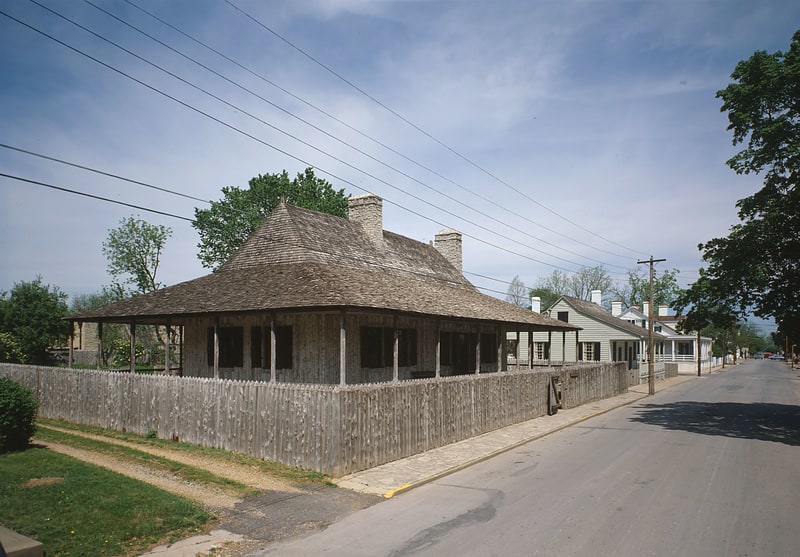
Museum in Ste. Genevieve, Missouri. The Louis Bolduc House, also known as Maison Bolduc, is a historic house museum at 123 South Main Street in Ste. Geneviève, Missouri. It is an example of poteaux sur solle construction, and is located in the first European settlement in the present-day state of Missouri. The first historic structure in Ste. Genevieve to be authentically restored, the house is a prime example of the traditional French Colonial architecture of the early 18th century in North America and was designated in 1970 as a National Historic Landmark.[1]
Address: 125 S Main St, 63670-1629 Sainte Genevieve
Amoureux House

Museum in Ste. Genevieve, Missouri. The Amoureux House, sometimes called the Beauvais–Amoureux House, is in Ste. Geneviève, Missouri. It was built in 1792 by Jean-Baptiste St. Gemme Beauvais II who moved from Kaskaskia, Illinois. In 1852, it was purchased by Benjamin C. Amoureux, who immigrated to the United States from France.
It is currently operated as a museum by the National Park Service. It is one of three surviving poteaux-en-terre buildings in Ste. Genevieve and one of five surviving in the entire United States. The other Ste. Genevieve poteaux-en-terre buildings are the Bequette-Ribault House and the Vital St. Gemme Beauvais House I (20 S. Main Street). The remaining two are the LaPointe-Krebs House in Pascagoula, Mississippi and the Badin-Roque House near Natchitoches, Louisiana. The Lasource–Durand Cabin is located behind the Amoureux House.[2]
Address: 327 St Marys Rd Ste. Genevieve, MO, 63670 Sainte Genevieve
Felix Vallé House State Historic Site

State park in Ste. Genevieve, Missouri. The Felix Vallé House State Historic Site is a state-owned historic preserve comprising the Felix Vallé House and other early 19th-century buildings in Ste. Genevieve, Missouri. It is managed by the Missouri Department of Natural Resources.
The site offers tours of the Felix Vallé House, a Federal-style limestone structure built in 1818 by Jacob Phillipson, a Jewish merchant from Philadelphia, Pennsylvania, that in 1824 became the commercial outlet and home of Felix Vallé and Odile Pratte-Vallé. An authentically stocked mercantile store representing the firm of Menard & Vallé is on display. Other features of the house include original mantels and interior trim, early Empire furnishings, an exterior staircase leading to the second-floor bedrooms, and a garden with original brick and frame outbuildings.
The Bauvais-Amoureux House (1792), which is open seasonally, and the Dr. Benjamin Shaw House (1819) are also part of the historic site.[3]
Address: 198 Merchant St, 63670-1682 Sainte Genevieve
Jacques Guibourd Historic House
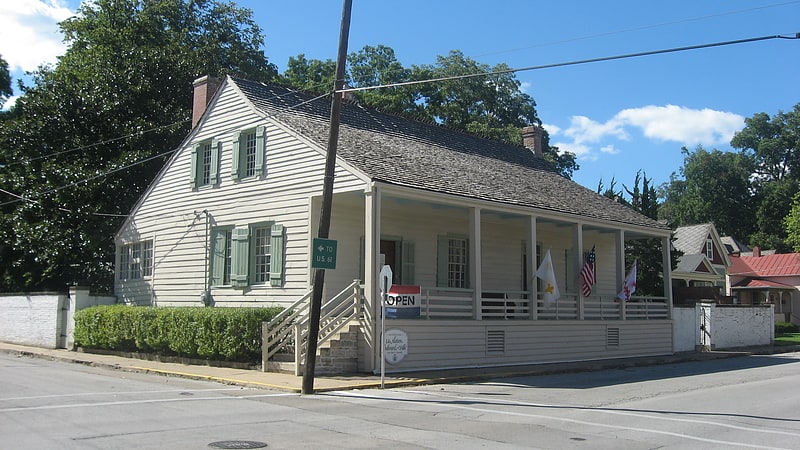
Building in Ste. Genevieve, Missouri. The Guibourd House, also known as La Maison de Guibourd, is an example of poteaux-sur-solle sealed with bouzillage construction. The structure was built around 1806 and was the home of Jacques Jean Rene Guibourd and his family.
The basic architecture of the Guibourd House is very similar to other Creole-French structures around the town and throughout the French inhabited regions of the Illinois Country/territory, eastern Canada and the Louisiana territory.
The structure's design has been changed only slightly over the years to accommodate the needs of the various residents, but overall retains much of the original character and style of the early 19th century French Creole architecture. The house had originally been built with 'galleries' (or wide porches) surrounding the house to keep the interior cool in the summer and the snow off in the winter.
The slave quarters or kitchen was added a few years later. The kitchen building was made of brick and detached from the main house due the added heat of cooking during the summer months, the smoke associated with cooking that would linger on cloth furnishings, and finally, because the French considered the smell of cooking to be offensive. (Contrary to the myth that kitchens were separate from the house due to the dangers of fire in the food preparation areas, extensive research has been done on the subject with no substantial facts to back it up. Refer to the book Death by Petticoat, by Mary Theobald, Colonial Williamsburg Press.) The Guibourd kitchen was built in a semi-attached fashion, under one corner of the porch. This proved invaluable for the family and slaves when serving meals to be able to keep them hot, dry and timely. The Guibourd House has one of the few original kitchen structures and slave quarters of this time period in Ste. Genevieve.
The woodwork found in Creole houses is similar to that of contemporaneous American houses, being fashioned probably by the same craftsmen. Glass was used early; the Guibourd house in Ste. Genevieve still has two pairs of casement windows similar to those found in Canada and Louisiana. Hardware and nails for Creole houses were imported at an early date, and three wrought-Iron door latches found in Ste. Genevieve show a close affinity to those of Quebec. The interior walls were often plastered and white-washed, and in more luxurious homes were sometimes frescoed or painted in panels, as in the Laclede-Chouteau house; but the ceilings were left open to show the carefully shaped beams (soUveaux), with their beaded moulding, and the attic flooring. Shrines and tall wooden crosses on inscribed stone pedestals added to the European appearance of the early settlements.
The immigration which began about the time of the American Revolution, and reached its full tide after the War of 1812, destroyed most of the Creole architectural traditions. Charles Dickens, visiting St. Louis in 1842, found that "In the old French portions of the town the thoroughfares are narrow and crooked, and some of the houses are quaint and picturesque, being built of wood, with tumble-down galleries.. and an abundance of crazy old tenements with blinking casements, such as may be seen in Flanders. Some of these ancient habitations, with high garret gable windows perking into the roofs, have a kind of French shrug about them; and being lopsided with age, appear to hold their heads askew, as if they were grimacing in astonishment at the American improvements..." But seven years after Dickens' visit, much of the French section was destroyed by fire, and two generations ago, the last house of the French type in St. Louis was pulled down.
The Guibourd House is a contributing property in the Ste. Genevieve Historic District, which is a National Historic Landmark. The house is operated as a historic house museum by the Foundation for Restoration of Ste. Genevieve, Inc.[4]
Ste. Genevieve Catholic Church
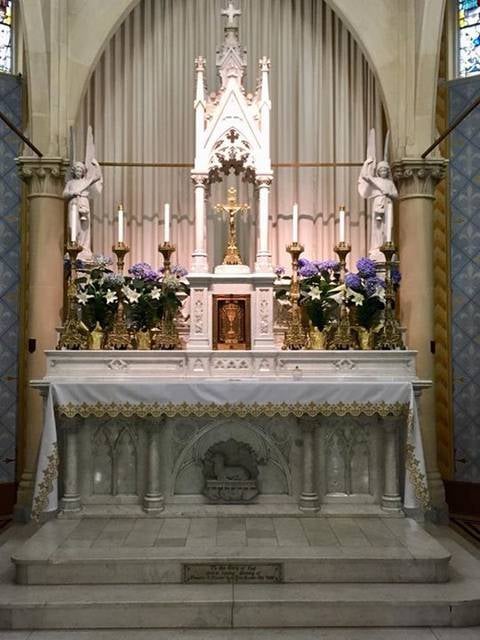
Catholic church in Ste. Genevieve, Missouri. Ste. Genevieve Catholic Church is a Roman Catholic church located in Ste. Genevieve, Missouri, the first organized European settlement west of the Mississippi River in the United States of America.[5]
Address: 49 DuBourg Place, Sainte Genevieve MO 63670, 63670-1398 Sainte Genevieve
Ste. Genevieve Memorial Cemetery
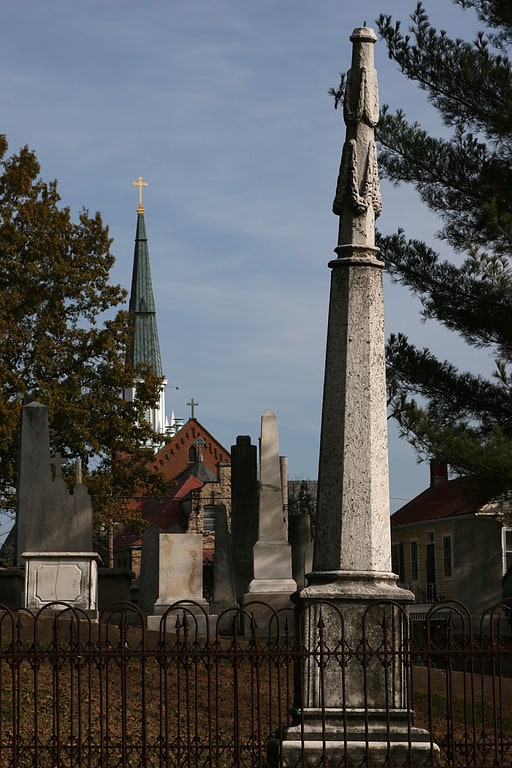
Memorial park. Ste. Genevieve Memorial Cemetery in Ste. Genevieve, Missouri, United States is a contributing site to both the Ste. Genevieve Historic District, and the associated National Landmark District.[6]
Ste. Genevieve Historic District
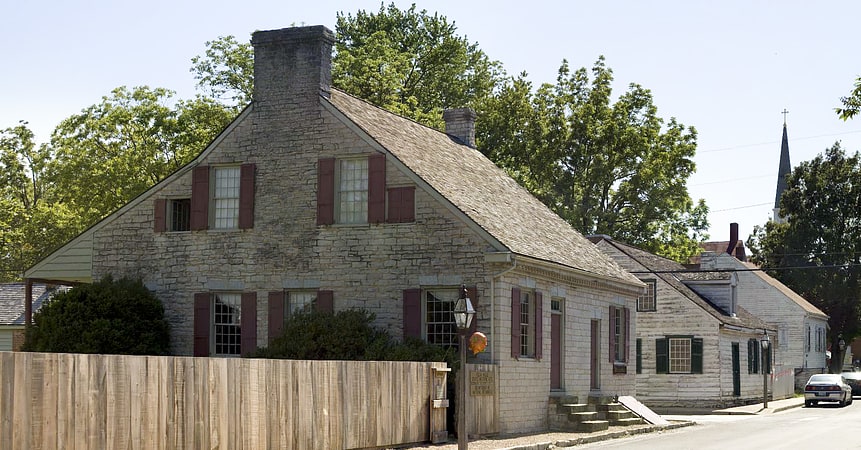
Ste. Genevieve Historic District is a historic district encompassing much of the built environment of Ste. Genevieve, Missouri, United States. The city was in the late 18th century the capital of Spanish Louisiana, and, at its original location a few miles south, capital of French Louisiana as well. A large area of the city, including fields along the Mississippi River, is a National Historic Landmark District designated in 1960, for its historically French architecture and land-use patterns, while a smaller area, encompassing the parts of the city historically important between about 1790 and 1950, was named separately to the National Register of Historic Places in 2002.
Ste. Genevieve is home to one of the highest concentrations of distinctive types of French colonial architecture known as poteaux en terre, or post in ground, and Poteaux-sur-sol, or post on sill. Both of these styles involve construction of walls consisting of vertical logs, the former placed directly into the ground, and the latter onto a horizontal sill of wood or stone. Prominent local examples of these architectural styles include the Beauvais-Amoureux House, the Felix Vallé House State Historic Site, La Maison de Guibourd, the Delassus-Kern House, the Louis Bolduc House (itself listed separately as a National Historic Landmark) and Old MillerSwitch Train station was a vital part of History proving supplies and Rest on the Old Railroad. In 2018, the National Park Service was authorized to establish Ste. Genevieve National Historical Park as a unit of the U.S. national park system, following a favourable study by the park service. It joined the park system on October 30, 2020.[7]